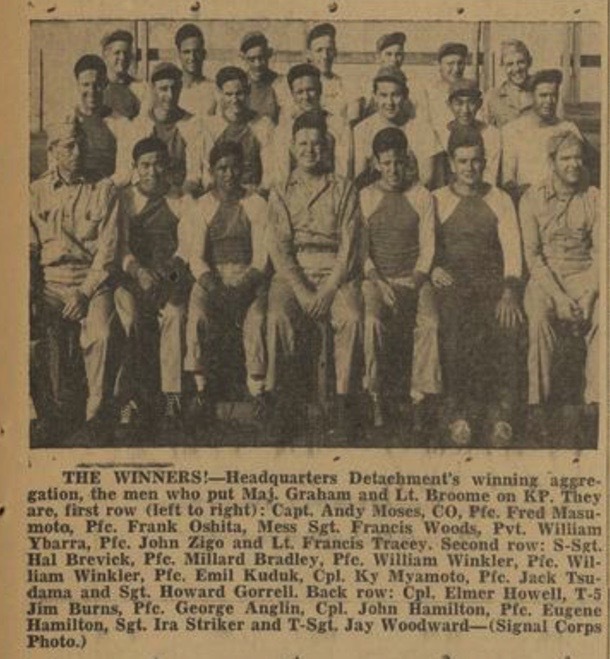Non-Segregated Minority Service Members
Locals may have been shocked to see so many new people arrive in North Texas day after day as the country shifted gears to mobilize for war. After all, the 1940 U.S. Population Census indicated Cooke County was not heavily populated nor very diverse, and the bustling life typical of crowded urban settings did not represent the lives of most Cooke County residents. On the other hand, Camp Howze appeared to be a microcosm of America, despite the uniform appearance of soldiers and their adherence to the Army's way of life. The people living and working at the camp came from all around the country and the world to serve the needs of the U.S. Army during World War II.
Much like the melting pot metaphor used to describe America's diversity, people poured into Camp Howze and the surrounding region a new mix of cultural, religious, and ethnic backgrounds that gained attention from the camp's weekly publication, the Camp Howze Howitzer.
Immigrant Soldiers
Fighting for freedom was not new to everyone who served at Camp Howze. Many of its soldiers were among the more than 300,000 foreign-born fighters who immigrated to America. They came from peaceful and war-torn countries with the hope of living a better life. As proof of their devotion to their adopted nation, they joined the military and swore to defend the country. After six months, in return for their honorable service, they could earn U.S. citizenship, a status that guaranteed fundamental rights many soldiers were denied by their birth nations. The Camp Howze Howitzer celebrated these naturalized citizens with articles highlighting their unique stories.
Latino Soldiers
According to the National World War II Museum, "over 500,000 Latinos (including 350,000 Mexican Americans and 53,000 Puerto Ricans)...served with distinction" in all military branches during WWII. The Camp Howze Howitzer appreciated their presence with articles highlighting some examples of Latino culture and music.
Filipino, Chinese, and Japanese American Soldiers
Despite Japan's brutal occupation of China and the Philippines during the Second World War, Americans of all three ancestries served together in the U.S. military. They fought for their shared belief in freedom from oppression. These soldiers earned praise from the Camp Howze Howitzer for their service to the country and allegiance to its democratic principles.
Religious Soldiers
Christianity was well represented at Camp Howze. Religious services were offered for at least six different denominations. With local churches and camp chapels open to soldiers year-round, numerous and convenient options for religious services were published in newspapers throughout the region, including the Camp Howze Howitzer. However, most services were restricted to "white" soldiers, as Dr. Rothacker C. Smith remembered in his WWII memoir, No Way Out: The Story of a WWII Black Buffalo Soldier. To attend Sabbath, he had to take a train to Fort Worth followed by a bus to Dallas, where he was welcomed at the African American Seventh-day Adventist church nearest to Camp Howze.
Though in smaller numbers, Camp Howze also recognized the existence of at least one minority group of non-Christians and supported them with spiritual leadership. Jewish service members received support from the Army, the USO, and Gainesville's Jewish community.
Although at first glance, the multitude of articles and photographs acknowledging the presence of so many historically underrepresented and marginalized American citizens gave the appearance of unity, there was always one exception to this facade of equality and inclusivity. Black service members remained permanently segregated and second to their "white" counterparts even in matters of religious faith.






















